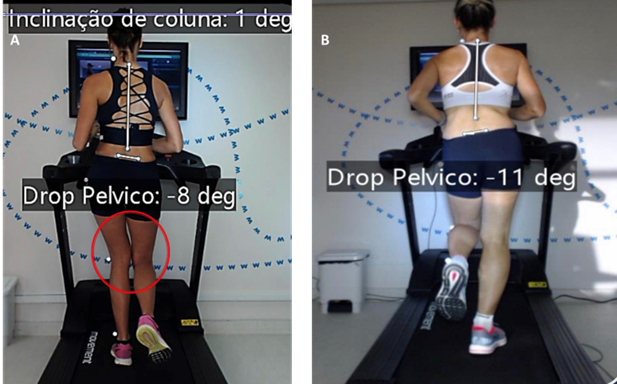Biomechanical analysis of running: correlation between main frontal findings and foot and ankle injuries in amateur runners
Main Article Content
Abstract
To correlate the most prevalent ankle and foot injuries in amateur runners with the biomechanical analysis of running, considering the patterns of frontal analysis evaluated in a private orthopedic and physical therapy service. Retrospective analysis of 56 medical records of amateur runners with ankle and foot complaints who underwent biomechanical assessment of running in an Orthopedics and Physical Therapy clinic in 2017 and 2018. Lesions found: Shin splints (26.78%); plantar fasciitis (21.42%); Achilles tendinopathy (21.42%); Tibial Stress Syndrome (8.92%); lower limb stress fractures (5.35%); posterior tibial tendonitis (5.35%); peroneal tendinopathy and ankle sprain (7.14%); talar chondral lesion (1.78%) and Morton’s neuroma (1.78%). The biomechanical analysis showed that the most common findings were valgus knees, with 43 cases (76.78%), followed by pelvic drop and center of mass vertical oscillation, with 40 cases each (71.42%) and hamstring retraction, with 37 cases (66.07%). Among the least prevalent, varus knees and supinated foot stand out, with two cases each (3.57%) and medial or lateral heel whip (5.35%, 3 cases). The most prevalent findings were valgus knee, pelvic drop, center of mass vertical oscillation, and hamstring retraction. Among the least present, stand out the varus knees, the supinated foot and the medial or lateral heel whip.
Article Details

This work is licensed under a Creative Commons Attribution 4.0 International License.
Authors retain the copyright of their articles and grant the journal the right of first publication under the Creative Commons Attribution (CC BY) license, which allows others to share and adapt the work with proper attribution.
References
Global Recommendations on Physical Activity for Health. WHO Guidelines Approved by the Guidelines Review Committee. Geneva: WHO Press, World Health Organization; 2010.
Taunton JE, Ryan MB, Clement DB, McKenzie DC, Lloyd-Smith DR, Zumbo BD. A retrospective case-control analysis of 2002 running injuries. Br J Sports Med. 2002 Apr;36(2):95-101. doi: 10.1136/bjsm.36.2.95.
Noehren B, Pohl MB, Sanchez Z, Cunningham T, Lattermann C. Proximal and distal kinematics in female runners with patellofemoral pain. Clin Biomech (Bristol, Avon). 2012 May;27(4):366-71. doi: 10.1016/j.clinbiomech.2011.10.005.
Noehren B, Schmitz A, Hempel R, Westlake C, Black W. Assessment of strength, flexibility, and running mechanics in men with iliotibial band syndrome. J Orthop Sports Phys Ther. 2014 Mar;44(3):217-22. doi: 10.2519/jospt.2014.4991.
Milner CE, Hamill J, Davis I. Are knee mechanics during early stance related to tibial stress fracture in runners? Clin Biomech 2007;22(6):697–703. doi: 10.1016/j.clinbiomech.2007.03.003.
Edwards WB, Taylor D, Rudolphi TJ, Gillette JC, Derrick TR. Effects of stride length and running mileage on a probabilistic stress fracture model. Med Sci Sports Exerc. 2009 Dec;41(12):2177-84. doi: 10.1249/MSS.0b013e3181a984c4.
Souza RB, Hatamiya N, Martin C, Aramaki A, Martinelli B, Wong J, Luke A. Medial and Lateral Heel Whips: Prevalence and Characteristics in Recreational Runners. PM&R. 2015;7(8):823–30. doi:10.1016/j.pmrj.2015.02.016.
Kilgore JE 3rd, Vincent KR, Vincent HK. Correcting Foot Crossover While Running. Curr Sports Med Rep. 2020 Jan;19(1):4-5. doi:10.1249/JSR.0000000000000670.
Noehren B, Davis I, Hamill J. ASB clinical biomechanics award winner 2006 prospective study of the biomechanical factors associated with iliotibial band syndrome. Clin Biomech (Bristol, Avon). 2007 Nov;22(9):951-6. doi: 10.1016/j.clinbiomech.2007.07.001.
Souza RB, Hatamiya N, Martin C, Aramaki A, Martinelli B, Wong J, Luke A. Medial and Lateral Heel Whips: Prevalence and Characteristics in Recreational Runners. PM R. 2015 Aug;7(8):823-830. doi: 10.1016/j.pmrj.2015.02.016.
Willson JD, Davis IS. Lower extremity mechanics of females with and without patellofemoral pain across activities with progressively greater task demands. Clin Biomech (Bristol, Avon). 2008 Feb;23(2):203-11. doi: 10.1016/j.clinbiomech.2007.08.025.
Powers CM. The Influence of Altered Lower‐Extremity Kinematics on Patellofemoral Joint Dysfunction: A Theoretical Per-spective Commentary. J Orthop Sports Phys Ther. 2003 Nov;33(11):639-46. doi:10.2519/jospt.2003.33.11.639.
Buchbinder MR, Napora NJ, Biggs EW. The relationship of abnormal pronation to chondromalacia of the patella in distance runners. J Am Podiatry Assoc. 1979 Feb;69(2):159-62. doi: 10.7547/87507315-69-2-159.
Tiberio D. The effect of excessive subtalar joint pronation on patellofemoral mechanics: a theoretical model. J Orthop Sports Phys Ther. 1987;9(4):160-5. doi:10.2519/jospt.1987.9.4.160.
Milner CE, Hamill J, Davis IS. Distinct hip and rearfoot kinematics in female runners with a history of tibial stress fracture. J Orthop Sports Phys Ther. 2010 Feb;40(2):59-66. doi: 10.2519/jospt.2010.3024.
Silbernagel KG, Willy R, Davis I. Preinjury and postinjury running analysis along with measurements of strength and tendon length in a patient with a surgically repaired Achilles tendon rupture. J Orthop Sports Phys Ther. 2012 Jun;42(6):521-9. doi: 10.2519/jospt.2012.3913.
Souza RB. An Evidence-Based Videotaped Running Biomechanics Analysis. Phys Med Rehabil Clin N Am. 2016 Feb;27(1):217-36. doi: 10.1016/j.pmr.2015.08.006.
Souza RB, Hatamiya N, Martin C, Aramaki A, Martinelli B, Wong J, Luke A. Medial and Lateral Heel Whips: Prevalence and Characteristics in Recreational Runners. PM R. 2015 Aug;7(8):823-830. doi: 10.1016/j.pmrj.2015.02.016.
Aranda Y, Munuera PV. Plantar fasciitis and its relationship with hallux limitus. J Am Podiatr Med Assoc. 2014 May;104(3):263-8. doi: 10.7547/0003-0538-104.3.263.
Akuthota V, Ferreiro A, Moore T, Fredericson M. Core stability exercise principles. Curr Sports Med Rep. 2008 Feb;7(1):39-44. doi: 10.1097/01.CSMR.0000308663.13278.69.
Niemuth PE, Johnson RJ, Myers MJ, Thieman TJ. Hip muscle weakness and overuse injuries in recreational runners. Clin J Sport Med. 2005 Jan;15(1):14-21. doi: 10.1097/00042752-200501000-00004.
Krivickas, LS. Anatomical Factors Associated with Overuse Sports Injuries. Sports Med. 1997 Aug;24(2):132-46. doi: 10.2165/00007256-199724020-00005.
Alfayez SM, Ahmed ML, Alomar AZ. A review article of medial tibial stress syndrome. J Musculoskelet Surg Res 2017;1:2-5.
Meardon SA, Derrick TR. Effect of step with manipulation on tibial stress during running. J Biomech. 2014 Aug 22;47(11):2738-44. doi: 10.1016/j.jbiomech.2014.04.047.
Nunns M, House C, Rice H, Mostazir M, Davey T, Stiles V, Fallowfield J, Allsopp A, Dixon S. Four biomechanical and an-thropometric measures predict tibial stress fracture: a prospective study of 1065 Royal Marines. Br J Sports Med. 2016 Oct;50(19):1206-10.
Lee J, Pathak P, Panday SB, Moon J. Effect of Foot-Planting Strategy on Anterior Cruciate Ligament Loading in Women During a Direction Diversion Maneuver: A Musculoskeletal Modeling Approach. Orthop J Sports Med. 2020 Nov 19;8(11):2325967120963180.
Adams D, Pozzi F, Willy RW, Carrol A, Zeni J. Altering cadence or vertical oscillation during running: effects on running related injury factors. Int J Sports Phys Ther. 2018 Aug;13(4):633-642.
